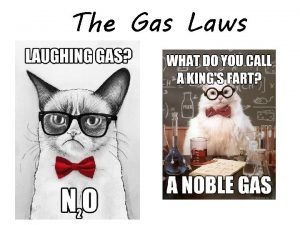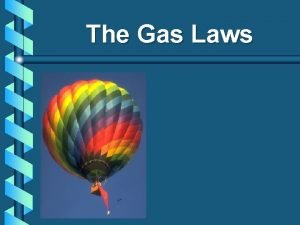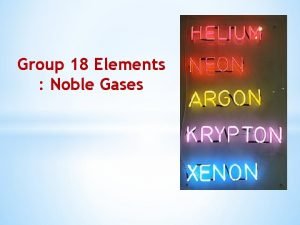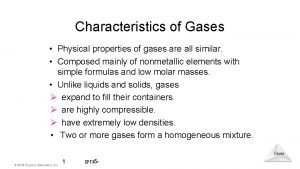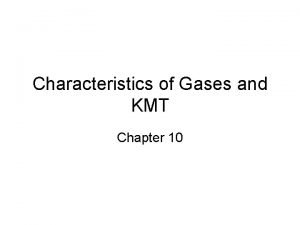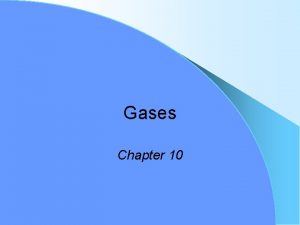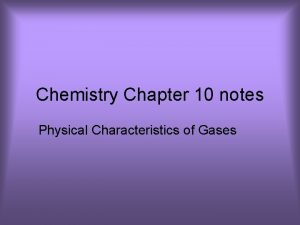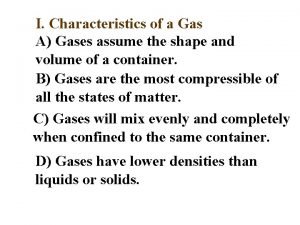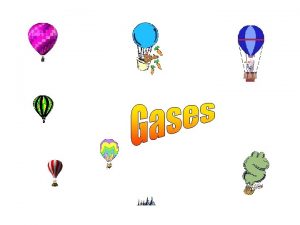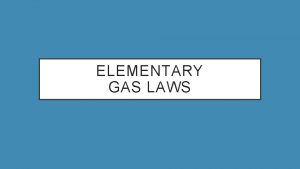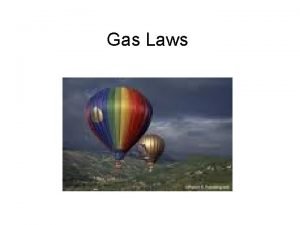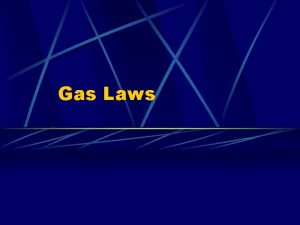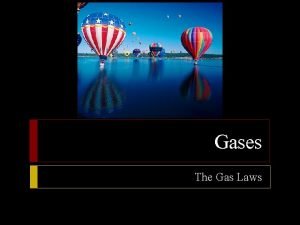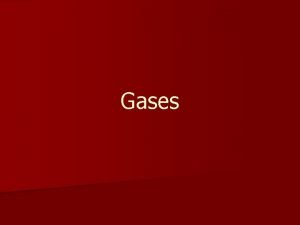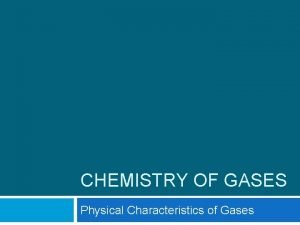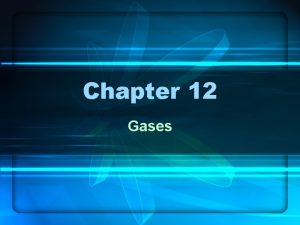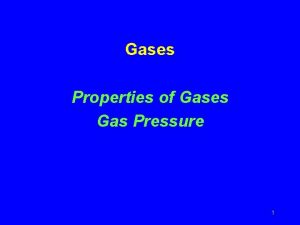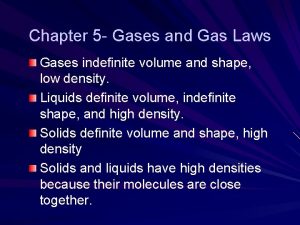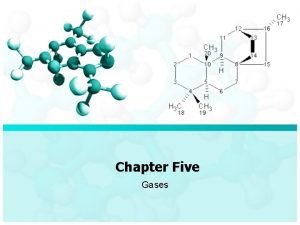GASES CONTENTS Gas and its characteristics Gas laws













- Slides: 13

GASES

CONTENTS • • • Gas and its characteristics Gas laws (Boyles law, Charles law and general gas equation) Value and units of R Kinetic molecular theory (KMT) Imp definitions Vrms

KEY TAKEAWAYS • Students must completely understand KMT • Students must be enabled to calculate value of R on the basis the units of variables • Students must be able to comprehend what is collision frequency, mean free path and Vrms

What are gases? • All matters exist in three states: gas, liquid and solid. • Gases have highest energy as compared to solids and liquids. • In a gaseous state, molecules remain separated wide apart in empty space and are free to move about throughout the container in which they are placed.

General characteristics of gases include • Expansibility : Gases have limitless expansibility because of little intermolecular attraction among the gas molecules. They expand to fill the entire vessel they are placed in. • Compressibility : Due to large intermolecular space, gases can be easily compressed by the application of pressure to a movable piston fitted in the container. • Diffusibility : Gases can diffuse rapidly through each other to form a homogeneous mixture. • Pressure Gases exert pressure on the walls of the container in all directions. • Effect of Heat When a gas, confined in a vessel is heated, its pressure increases.

Gas Laws • Effect of external parameters on behavior of a gas is explained by gas laws • There are four external parameters that effect gases including • • Volume (V) Pressure (P) Temperature (T) Number of moles (n)

Boyles law • At constant temperature, the volume of a fixed mass of gas is inversely proportional to its pressure. • If the pressure is doubled, the volume is halved. • The Boyle’s Law may be expressed mathematically as- V ∝ 1/P (T, n are constant) Or V = k × 1/P Where, k is proportionality constant. So, PV = k If P 1, V 1 are the initial pressure and volume of a given sample of gas and P 2, V 2 the changed pressure and volume, P 1 V 1 = k = P 2 V 2 • This relationship is useful for the determination of the volume of a gas at any pressure, if its volume at any other pressure is known.

Charles law • At constant pressure, the volume of a fixed mass of gas is directly proportional to the temperature of the gas. V = k. T • If the absolute temperature is doubled, the volume is doubled. • If V 1, T 1 are the initial volume and temperature of a given mass of gas at constant pressure and V 2, T 2 are the final volume and temperature than V 1/T 1= V 1/T 1

Kinetic Molecular Theory (KMT) • Describes the ideal behavior of gases: • The volume of the molecule is negligible compared to the large distances between the molecules. • Gas molecules are so far apart, that they do NOT have intermolecular interaction. • Gas molecules do NOT interact, but they move around fast and they constantly collide with one another. • Kinetic Energy: • Same temperature, same average kinetic energy (KEavg). • The higher the temperature, the higher the kinetic energy (KEavg).

Ideal Gas/Ideal Gas Law/Ideal Gas Equation • Ideal Gas: behaves in accordance to combined gas law and follows postulates of KMT Combined Gas Law: ���� /���� =R = �������� This rearranges to Ideal Gas Equation PV= n. RT R = universal gas constant • Units and Values of R is according to the units of the variables used. T should be in Kelvins (K) always.

Derivation of value of R

Some important definitions • The mean free path is the distance that a molecule travels between two successive collisions. • Collisional Frequency is the average rate in which two reactant molecules collide for a given system and is used to express the average number of collisions per unit of time in a defined system. • The distance between the centers of two molecules taking part in a collision at the time of their closest approach is called collision diameter

Root-Mean-Square Velocities of Gaseous Particles Measuring the velocities of particles at a given time results in a large distribution of values; some particles may move very slowly, others very quickly, and because they are constantly moving in different directions, the velocity could equal zero. (Velocity is a vector quantity, equal to the speed and direction of a particle) To properly assess the average velocity, average the squares of the velocities and take the square root of that value. This is known as the root-mean-square (RMS) velocity, and it is represented as follows: V=Vrms=√ 3 RT/M (The end)
 Useless laws weaken the necessary laws
Useless laws weaken the necessary laws Direct vs indirect relationship
Direct vs indirect relationship Are gasses highly compressible
Are gasses highly compressible Properties of noble gases
Properties of noble gases Characteristics of gases
Characteristics of gases Gases characteristics
Gases characteristics Physical characteristics of gases
Physical characteristics of gases Physical characteristics of gases
Physical characteristics of gases Physical characteristics of gases
Physical characteristics of gases Characteristics of ideal gases
Characteristics of ideal gases Ideal gas characteristics
Ideal gas characteristics Wanted a just right government true'' or false
Wanted a just right government true'' or false The bright filled paperweight
The bright filled paperweight Its halloween its halloween the moon is full and bright
Its halloween its halloween the moon is full and bright

